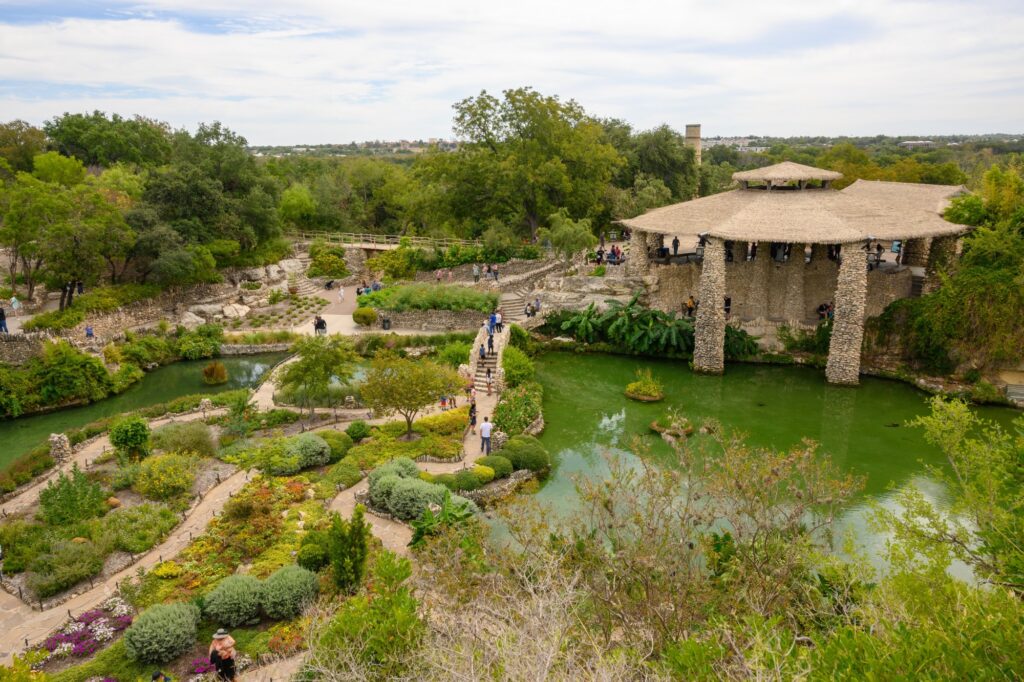
The Japanese Tea Garden in San Antonio, Texas, is a hidden gem that offers a serene and enchanting escape from the bustling city. Nestled within the lush greenery of Brackenridge Park, this captivating oasis transports visitors to a realm of tranquility, where the art of Japanese culture and the beauty of nature converge.
Established in the late 19th century, the Japanese Tea Garden has evolved over the decades, becoming a beloved destination for locals and tourists alike. Its rich history, intricate architecture, and well-manicured landscapes make it a must-visit attraction for anyone seeking a moment of respite and cultural immersion.
History of the Japanese Tea Garden
The origins of the Japanese Tea Garden can be traced back to the late 1800s, when the land was part of a former cement quarry. In 1899, the area was transformed into a Japanese-style garden, known as the Japanese Pagoda, as part of the city’s Sunken Garden project. Over the years, the garden underwent several renovations and expansions, each one adding to its unique charm and cultural significance.
In the 1920s, the garden was renamed the Japanese Tea Garden and underwent a major transformation, with the addition of a teahouse, bridges, and other architectural elements that reflected the Japanese aesthetic. The garden’s design and features were heavily influenced by the work of renowned landscape architect Jens Jensen, who helped to create a harmonious blend of Japanese and American elements.
Features and Attractions of the Japanese Tea Garden
The Japanese Tea Garden in San Antonio is a true feast for the senses. Visitors are immediately captivated by the serene ponds, cascading waterfalls, and meticulously manicured landscapes that create a sense of tranquility and balance.
One of the garden’s most iconic features is the stone bridge, which spans a tranquil pond and offers breathtaking views of the surrounding scenery. The bridge, with its distinctive arched design, is a popular spot for photographs and a favorite among visitors.
Another must-see attraction is the historic teahouse, which was originally constructed in the 1920s and has been meticulously restored over the years. Visitors can step inside the teahouse and immerse themselves in the rich traditions of Japanese tea culture, enjoying a cup of authentic Japanese tea and experiencing the serene ambiance.
The garden also features a variety of other architectural elements, including pagodas, stone lanterns, and intricate stone carvings, all of which contribute to the overall Japanese aesthetic.
The Significance of Tea Ceremonies in Japanese Culture
Tea ceremonies, or chanoyu, are an integral part of Japanese culture and hold deep spiritual and social significance. The practice of the tea ceremony, or “way of tea,” is a highly ritualized and refined art form that emphasizes the importance of mindfulness, hospitality, and the appreciation of beauty in everyday life.
At the Japanese Tea Garden in San Antonio, visitors have the opportunity to witness or participate in traditional tea ceremonies, where they can learn about the history, symbolism, and etiquette associated with this cultural tradition. Skilled tea masters guide participants through the intricate steps of the ceremony, from the preparation of the tea to the presentation and sharing of the beverage.
Through these tea ceremonies, visitors gain a deeper understanding and appreciation of the Japanese culture, its values, and the role that tea plays in fostering community, reflection, and a connection with nature.
Exploring the Beautiful Landscapes and Architecture of the Garden
The Japanese Tea Garden in San Antonio is a true feast for the senses, with its stunning landscapes and captivating architecture. As visitors wander through the garden, they are treated to a visual feast of lush greenery, serene ponds, and cascading waterfalls.
The garden’s meticulously manicured landscapes are a testament to the Japanese aesthetic, with carefully pruned trees, sculpted shrubs, and vibrant blooms that create a sense of harmony and balance. Visitors can stroll along winding pathways, cross bridges, and discover hidden nooks and crannies that offer unique perspectives of the garden’s beauty.
The architectural elements of the Japanese Tea Garden are equally impressive, with structures that seamlessly blend traditional Japanese design with local materials and influences. The iconic stone bridge, pagodas, and stone lanterns all contribute to the garden’s distinctive character, transporting visitors to a different time and place.
One of the most captivating features of the garden is the historic teahouse, which stands as a testament to the enduring influence of Japanese culture. The teahouse, with its intricate wooden beams and sliding shoji screens, offers a glimpse into the traditions and rituals associated with the art of tea-making.
Events and Cultural Activities at the Japanese Tea Garden
The Japanese Tea Garden in San Antonio is not just a place to admire the natural beauty and architectural wonders; it is also a hub for cultural events and activities that celebrate the rich heritage of Japan.
Throughout the year, the garden hosts a variety of events and programs that allow visitors to immerse themselves in the traditions and customs of Japanese culture. From traditional tea ceremonies and calligraphy demonstrations to cultural festivals and art exhibits, there is always something new and exciting to discover.
One of the most popular events at the Japanese Tea Garden is the annual Sakura Festival, which celebrates the blooming of the cherry blossom trees. During this festival, visitors can enjoy traditional Japanese music and dance performances, participate in hands-on workshops, and indulge in authentic Japanese cuisine.
Other events, such as the Lunar New Year celebration and the Obon Festival, offer visitors the opportunity to learn about the significance of these cultural traditions and participate in the festivities. These events not only educate and entertain but also foster a deeper appreciation for the cultural diversity that enriches the San Antonio community.
Tips for Visiting the Japanese Tea Garden
Visiting the Japanese Tea Garden in San Antonio can be a truly rewarding experience, but there are a few tips to keep in mind to make the most of your visit:
- Timing is Key: The garden is open year-round, but the best times to visit are during the spring and fall when the weather is mild and the gardens are in full bloom.
- Wear Comfortable Shoes: The garden features several winding paths and uneven terrain, so it’s important to wear comfortable, supportive shoes to fully explore the grounds.
- Bring a Camera: The Japanese Tea Garden is a photographer’s paradise, with endless opportunities to capture the stunning landscapes, architecture, and cultural activities.
- Participate in a Tea Ceremony: If possible, try to attend a traditional tea ceremony to immerse yourself in the rich cultural traditions of Japan.
- Allow Ample Time: The garden is quite large, and there is much to see and experience, so plan to spend at least 1-2 hours exploring the grounds.
- Dress Appropriately: While the garden is generally casual, it’s a good idea to dress modestly and respectfully, especially when participating in cultural events or activities.
Nearby Attractions and Activities in San Antonio
The Japanese Tea Garden is just one of the many incredible attractions that San Antonio has to offer. Located in the heart of the city, the garden is surrounded by a wealth of other must-see destinations and activities that can enhance your visit.
One of the most popular nearby attractions is the San Antonio River Walk, a vibrant, pedestrian-friendly promenade that winds along the banks of the San Antonio River. Visitors can stroll, dine, and explore the many shops, restaurants, and cultural sites that line the river’s edge.
Another must-visit destination is the Alamo, the iconic historical site where the famous battle of the Texas Revolution took place. Visitors can learn about the Alamo’s rich history and explore the grounds, which have been meticulously preserved to honor the memory of the brave Texans who fought and died there.
For those interested in the arts, the McNay Art Museum, located just a short distance from the Japanese Tea Garden, offers an impressive collection of modern and contemporary art, as well as rotating exhibitions and cultural events.
And for those seeking outdoor adventures, the nearby Brackenridge Park offers a wealth of opportunities for hiking, biking, and exploring the natural beauty of the area.
Local Dining Options near the Japanese Tea Garden
After exploring the tranquil beauty of the Japanese Tea Garden, visitors will find a variety of delicious dining options nearby to satisfy their appetites.
One of the most popular local restaurants is the Grill at the Japanese Tea Garden, which offers a menu of Japanese-inspired cuisine, including sushi, ramen, and traditional dishes. The restaurant’s serene setting, overlooking the garden’s ponds and waterfalls, creates a truly immersive dining experience.
For those seeking a more casual dining experience, the nearby Alamo Beer Company offers a selection of craft beers and pub-style fare, perfect for a post-garden refreshment.
Visitors can also explore the diverse culinary offerings of the nearby Pearl District, a vibrant neighborhood known for its eclectic mix of restaurants, cafes, and artisanal food purveyors. From farm-to-table eateries to global cuisine, the Pearl District offers something to suit every palate.
Enjoy
The Japanese Tea Garden in San Antonio is a true gem, offering visitors a unique blend of tranquility, cultural immersion, and natural beauty. Whether you’re seeking a peaceful respite from the hustle and bustle of the city or a deeper understanding of Japanese traditions and customs, this captivating oasis is sure to leave a lasting impression.






